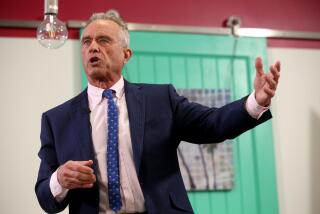Striking a Chord : Procedure Helps Parkinson’s Patients Regain Their Voices
- Share via
10:15 a.m.
Robert Berglund, 53, sits quietly outside the Head and Neck Surgical Suite at UCLA Medical Plaza. A victim of Parkinson’s disease, he has not spoken above a whisper for more than four years.
“He has always been a very witty guy,” says his wife, Mary Lee Berglund, who drove them to the hospital Friday morning from their home in Toluca Lake. “He loved to talk to people.”
Berglund--nattily dressed in a blue blazer, striped blue shirt and tan slacks--was once the national sales manager for the CBS owned and operated television stations.
“He had a beautiful singing voice, he could do Billy Eckstine,” she says, trading smiles with her husband.
“It’s so frustrating for him.”
Until a few months ago, there was no treatment available to give Berglund back his voice. There is no cure for Parkinson’s. “It’s a degenerative disease,” says Robert Berglund, softly.
But at UCLA, an experimental procedure that has been tried on a handful of Parkinson’s patients has shown great promise in strengthening speech, according to the institution’s doctors.
Berglund is about to become the approximately 15th patient ever to undergo this quick, inexpensive and relatively simple treatment during which collagen--an animal protein best known for its use in cosmetic surgery--is injected directly into the vocal cords.
If all goes well, about an hour from now Berglund will be able to speak in a near normal voice.
10:44 a.m.
Berglund is ushered into a treatment room by Kathy Jackson, a registered nurse. She sprays the back of his throat with a lidocaine anesthetic that is clearly, from the look on Berglund’s face, foul tasting.
Jackson sympathizes, but tells him that next comes a benzocaine spray. She gives him fair warning. “See here where it says it’s cherry flavored and tastes good?” she asks, showing him the can of benzocaine.
“They’re lying.”
Dr. Gerald Berke, who came up with the procedure, wanders in to check on the patient and then quickly rushes out to finish another surgery he is doing in a nearby room.
Using collagen to augment speech organs is an idea that originated in France about seven years ago, Berke said in an interview. “But they thought you needed to put the patient asleep,” he said. That’s a major problem for Parkinson’s patients.
“If you use general anesthesia on a Parkinson’s patient, they can actually get worse,” said Dr. Matthias Kurth, the assistant clinical director of the National Parkinson’s Foundation.
But about two years ago, doctors began to treat voice problems caused by spasmodic dysphonia--a condition that makes vocal cord muscles overcontract--with direct injections of botulinus toxin to loosen them.
The procedure was done with a local anesthetic. “The key is that the needle has to be very skinny,” Berke said, speaking of the hypodermic needle that pierces the patient’s neck. “It doesn’t hurt and you can control it accurately.
“So, I thought we could do this with collagen, too” to fill out the flaccid cords of Parkinson’s patients.
He first tried it about eight months ago. The results, he said, have been “good, very good,” with all the patients so far winding up with stronger, if imperfect, voices.
The effect of the collagen wears off in three to four months and to retain the benefits the procedure, which Berke said costs only about $500, needs to be repeated.
Berke said that after he tests this method on several more patients, he will write about his findings for a medical journal.
“It’s very exciting, very encouraging,” said Kurth, when the operation was described. “This could be a real advance.”
For Mary Lee Berglund, even a slight improvement would be welcomed.
“He’s a great listener, women love him,” she says with her almost ever-present smile. “But if he could even just be understood on the telephone it would mean a lot.”
10:52 a.m.
Berke returns. “Let’s go ahead and do this,” he says reassuringly, slipping a tiny video camera--positioned at the end of a thin, fiber optic cable--up Berglund’s right nostril. After a few seconds, the camera is in place in Berglund’s throat and an adjacent monitor shows a clear image of his larynx. Berke picks up the syringe.
“I’ve never had a bad reaction to this,” he tells Berglund.
“How many have you performed?” Berglund asks.
“About 100,” the doctor answers, including the injections he has done for spasmodic dysphonia.
Berglund nods and Berke pushes the needle into the front of his patient’s neck. The doctor watches the video screen to guide the tip of the needle directly into the right vocal cord. A bit of collagen is injected and the cord immediately puffs up.
“Halfway done,” Berke says. He withdraws the needle and moves to the left side. A moment later, the procedure is complete.
11:02 a.m.
“Say one, two, three,” says Berke.
“One, two, three,” says Berglund.
His voice is deeper, more resonant.
“I can hear a difference,” says Mary Lee Berglund, standing just outside the door of the treatment room.
“Say it again,” says Berke.
“One, two, three,” says Berglund, a bit louder.
The change was indeed noticeable, though not dramatic.
“Try talking more,” says Mary Lee Berglund.
Berglund says a few more words. The volume has come up another notch, although his speech is still slurred.
“It’s definitely better,” says Mary Lee Berglund.
Berglund’s voice is still considerably short of normal, although Berke says that it will probably continue improving as liquid drains out of the collagen over the next several days.
“C’mon, sing,” urges Mary Lee Berglund.
Berglund smiles, cocks his head and softly begins to sing, “Cottage for sale . . . “
It’s an old Billy Eckstine song. But he’s interrupted after only three words by questions from a UCLA administrator who pops her head into the room.
The Berglunds leave a few minutes later with optimism intact.
“Let’s go call your mother,” Mary Lee Berglund says as they make their way to the parking lot.
“Soon,” she says, “he’ll be doing standup.”
More to Read
Sign up for Essential California
The most important California stories and recommendations in your inbox every morning.
You may occasionally receive promotional content from the Los Angeles Times.











